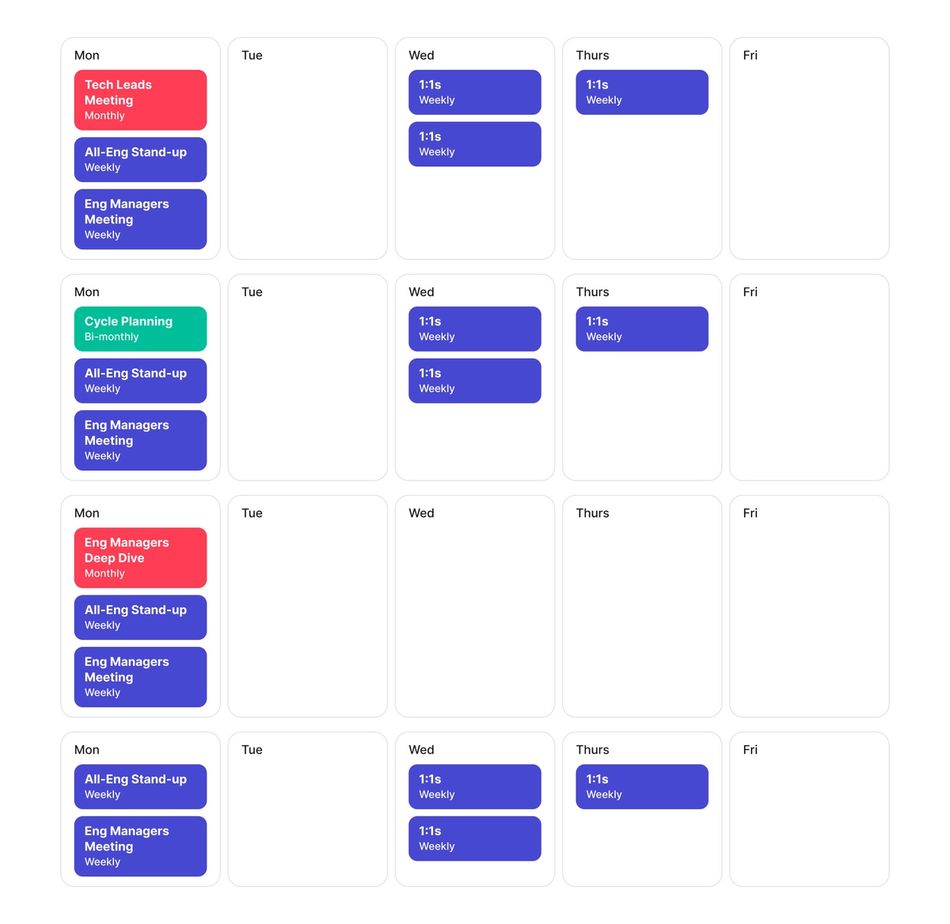Leading a team, especially a distributed or growing one, can be hard. Oftentimes the best advice and ideas come from other teams just like yours. That’s why we launched Lead Time: How Teams Work. This blog series profiles real teams, how they’re structured, and how they communicate through meetings and other touchpoints. Plus, each article features a top-notch leader who's got proven tips and real stories to learn from.
Meet Sarah Milstein, former VP of Engineering at ConvertKit
Sarah’s a long-time startup leader with experience leading Eng teams at Mailchimp, ConvertKit, and most recently Daily. We interviewed her back when she was at ConvertKit, so this post will dive deep on her team structure and communication cadence there, as well as some broader learnings she’s picked up on leadership along the way.
How the team works
Team structure
At ConvertKit, Sarah’s engineering team consisted of 20 ICs and 3 managers divided up across 4 squads. Each squad was “somewhat cross-functional” in nature, with several engineers, an eng manager, and a designer.
Team meetings and communication cadence
The team operated on 6-week cycles — here’s a sample of their meeting and communication cadence over that time period.

Daily: Day-to-day communication happens primarily in Slack.
- Engineering channel: A channel for the whole team, devoted to all-things engineering.
- Eng managers channel: Each morning, eng managers post daily updates to this channel, following a 2-part structure: (1) How are you feeling? and (2) What are your priorities today?
- Squad channels: Each of the squads has their own channel for updates and discussion about projects they’re actively working on.
- “Potato” channel: A channel for checking in and accountability throughout the day — folks will post updates like ‘I'm in for the morning ☕️’ or ‘I'm going to lunch 🌮.’
Weekly:
- Eng managers meetings: Sarah and the eng manager meet each week to discuss how everyone’s doing and check in around metrics and goals.
- All-eng standup: A 30 minutes meeting that’s less traditional than your typical stand-up and changes shape each week. Some examples include: an AMA with Sarah or other leaders, a team-wide discussion on a technical or process topic, a lunch and learn with someone on the team who wants to go deeper on something technical, or dedicated time for a get-to-know-you or team-building activity.
- 1:1s: Managers and their direct reports meet each week to discuss work-in-progress and career development.
- No-standing-meeting Tuesdays and Fridays: The ConvertKit team keeps Tuesdays and Fridays free of standing meetings for two reasons. (1) It makes it easier for the teams to move quickly, both freeing up time on everyone’s calendars and making it possible to find collab-time if folks need to work through blockers and problem-solve together. (2) It keeps their meeting load light — forcing the team to think more critically about what meetings are actually necessary.
Monthly:
- Eng managers deep dive: In addition to their weekly meeting, Sarah and the eng managers come together for a 90-minute meeting each month to cover bigger topics they’re not able to get through in the weekly meetings.
- Tech leads meeting: A space to work through Eng-wide issues or assign who's going to tackle something that needs attention.
Bi-monthly:
- Cycle-planning: The team operates on 6-week cycles. To kick off each cycle, the tech leads meet to plan for the cycle ahead and map out eng-specific work. They discuss interdependencies and raise issues to ensure everyone’s aligned across all of the squads.
Sarah’s top tips for running a remote organization
1. Give every meeting a clear purpose
Sure, meeting overload and Zoom fatigue are very real, but that doesn’t mean all meetings are bad. In fact, meetings serve a number of valuable meta-purposes or implicit goals: they foster team connection and bonding, give us an avenue to share information and make decisions, provide space for teams to brainstorm and collaborate, and more.
Where teams tend to go wrong with meetings, says Sarah, is when they’re not crystal clear about what they’re trying to accomplish with the time together. This can make meetings feel like a waste of time and lead to decreased engagement, since folks aren’t sure why they’re there and what value they can add to the conversation.
“Be really explicit about why you’re meeting and communicate that to everyone involved,” recommends Sarah. “Think: What’s the purpose of this time together?”
For many teams, meetings are a common way to share information and updates with one another. Sarah says she’s found that sharing certain types of information is actually much easier to do asynchronously instead. It’s also easier to catch up on after the fact — since there’s a clear written record of what’s happening.
“If you’re going to go that route, you can then use your meetings for personal connection and decision-making. Figuring out how to do those things really well is a good investment,” she adds.
2. Build experimentation into your meeting culture
To figure out how to do those things really well, Sarah encourages teams to experiment with their meetings on a regular cadence.
“Meetings need to be regularly refreshed and rethought, so they’re really well-suited for experimentation” she explains.
Here’s a look at Sarah's process for experimenting and iterating on her team’s meetings.
Sarah’s meeting experimentation framework
Step 1: Clarify your purpose
Ask yourself and your team the following questions.
- What’s the primary thing we’re trying to accomplish with the meeting? What’s our goal?
- Are we successfully accomplishing it? If not, what’s getting in our way?
- Are there any other problems with this meeting or things that just aren’t working?
Step 2: Come up with ideas
Ask yourself and your team the following questions.
- With the purpose in mind, what would make our time together even more impactful?
- What other ways can we achieve the same purpose that might look differently than what we’re doing today?
- What are some ways we can solve the problems we’ve identified?
Step 3: Pick one, and experiment with it
Choose one of the ideas you outlined in step 2 and commit to testing it out for a set amount of time.
“When people are given an end date to something — “we’ll check back in 3 months from now” — they’re a lot more open to trying something new,” Sarah explains.
Step 4: Check back in, and iterate
After your experiment’s time period comes to an end, check back in with the team to collect feedback on how it went, decide whether or not the change is working for your team, and share ideas on how to iterate or try something new going forward.








